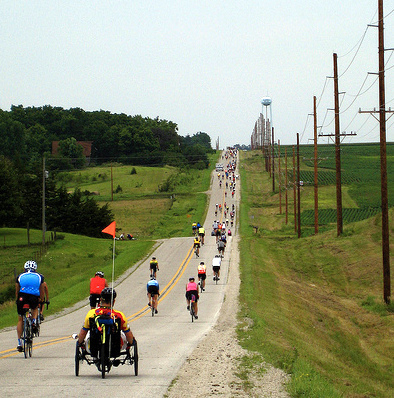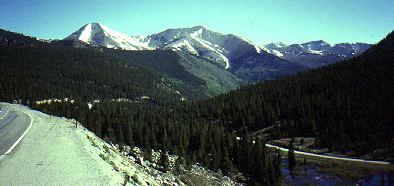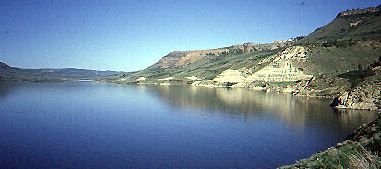 Bicycling enthusiasts know the Register's Annual Great Bike Ride Across Iowa (RAGBRAI) and the Denver Post Ride the Rockies as two iconic cross-state bicycle tours with a combined history of 65 years.
Bicycling enthusiasts know the Register's Annual Great Bike Ride Across Iowa (RAGBRAI) and the Denver Post Ride the Rockies as two iconic cross-state bicycle tours with a combined history of 65 years.
RAGBRAI is the easy one that rolls across the flatness of Iowa. Ride the Rockies is the challenging one that summits mountain passes nearly every day.
Those myths don't exactly bear up to the facts, however.
In terms of elevation gain — which should really be the yardstick for comparing a flat ride and a mountainous ride — there's not much difference between the two.
Challenging days
In fact, bicycle riders on 2011 RAGBRAI face more climbing in each of their first two days this year than the Ride the Rockies cyclists will face on any day of their six-day ride over six mountain passes.
This might not be surprising to bicyclists who regularly ride RAGBRAI, but it was kind of shocking to me.
The total elevation gain for the 2011 Ride the Rockies bike route announced on Sunday is 21,604 feet. I was amazed by that total, until I went back to check the RAGBRAI route and discovered that cyclists in “flat” Iowa would climb 21,206 feet.
Rolling hills vs. mountain passes
OK, the RAGBRAI cyclists accomplish that in 7 days and the Ride the Rockies cyclists do it in 6 days.
But looking at the day-to-day elevation gain, RAGBRAI cyclists climb 4,946 feet the first day and 4,798 feet the second day. Each day is about 65 miles.
The most elevation gain in one day for Ride the Rockies cyclists this year is 4,314 feet; that's the day they ride 76 miles over Cottonwood Pass at 12,126-foot elevation.
 It was news to me that RAGBRAI rivaled Ride the Rockies in difficulty, so I hunted around the Internet until I found the expert on RAGBRAI trivia. That's Rich Ketcham, a software consultant who has been crunching all the RAGBRAI numbers and has them all online at GeoBike.com.
It was news to me that RAGBRAI rivaled Ride the Rockies in difficulty, so I hunted around the Internet until I found the expert on RAGBRAI trivia. That's Rich Ketcham, a software consultant who has been crunching all the RAGBRAI numbers and has them all online at GeoBike.com.
Stats
He confirmed my discovery.
“I have to admit that I, too, was a bit surprised at the amount of climb we do on some of the RAGBRAI rides. It is real! By my count, 12 of the RAGBRAIs have exceeded 22,000 feet of climb. The record was RAGBRAI IX which had over 26,000 feet of climb.”
Rich rode in a couple of Ride the Rockies bike tours as well, so he can compare the two bike tours.
“As a point of reference, a typical RTR day experiences most of its climb doing a single pass. A rider is subjected to a long, sustained climb that can exceed 5000 feet. On the plus side, the payback is the long decent that follows.
“I remember going from Gunnison to Salida via Monarch Pass where we had ~8 miles of sustained climb followed by ~23 miles of downhill.
“Switching to RAGBRAI, most people think that Iowa is flat. Although there are plenty of areas where this is true, Iowa also has plenty of areas that are extremely hilly. This is a result of a vast number of watersheds that exist, which ultimately feed into the Missouri and Mississippi river basins. These hills are most noticeable in W, SW, and S Iowa.
“These don’t present long sustained climbs, but rather a series of climbs and descents. It’s not unusual to experience climbs of 100+ feet followed by similar decents, for 20 to 30 miles or more. …”
 Technique
Technique
Ugh. Rollers. Those can be brutal. Rich went on about how cycling techniques differ on Ride the Rockies compared to RAGBRAI.
“When shooting a pass on RTR, the name of the game is to find the gear that sets a torque load that you can sustain for the duration of the climb (gut it out). A technically proficient rider on RAGBRAI will be challenged by the number of gear changes they will be subjected to and the rate at which they occur. A rider from Colorado who did the afore mentioned RAGBRAI day complained that he couldn’t find a gear to stay in. He was trying to maintain a constant cadence and lost count after shifting over 100 times.”
Conditions
Further, Rich points out that the high humidity can take its toll on RAGBRAI riders, whose clothing becomes drenched with sweat. The dry Rocky Mountain air evaporates the sweat on Ride the Rockies cyclists, keeping them cool.
Of course, it can be difficult to get enough oxygen while nearing the summit of those high-altitude passes. Rich also remembers cycling over Lizard Head Pass and hitting snow and freezing rain on the way down. He flagged the SAG wagon. He concludes:
“It is safe to say that each ride has its own unique conditions and demands. Riders need to understand these, train accordingly, and come to the ride prepared.”
That's great advice. The RAGBRAI website offers a training blog and pages road safety and etiquette. The Ride the Rockies website also offers online information about training, nutrition and safety.
Busted
Ride the Rockies rolls out June 11-17 and is followed by RAGBRAI on July 24-30 this year.
I'd say that we've busted the myth that RAGBRAI is an easy bike tour. It rivals, and in some years surpasses, the difficulty of Ride the Rockies.
So if this year's RAGBRAI cyclists are exhausted after their first two days, they can be assured that it's not necessarily because they're out shape. They can rest with the knowledge that they've climbed the equivalent of a couple of Colorado mountain passes.
Comparison
Here's a day-to-day comparison of the two rides:
Ride the Rockies
Day 1: 76 miles; 4,314 feet
Day 2: 76 miles; 3,416 feet
Day 3: 80 miles; 3,776 feet
Day 4: 52 miles; 2,122 feet
Day 5: 78 miles; 4,063 feet
Day 6: 50 miles; 3,913 feet
RAGBRAI
Day 1: 64 miles; 4,946 feet
Day 2: 65 miles; 4,798 feet
Day 3: 71 miles; 1,784 feet
Day 4: 56 miles; 1,246 feet
Day 5: 58 miles; 3,294 feet
Day 6: 75 miles; 2,800 feet
Day 7: 65 miles; 2,338 feet
Photo at top by BlueBike at Flickr.com from Day 2 of RAGBRAI XXXVII. Other photos from my cross-country bike tour.

6 comments
2 pings
Skip to comment form
Bunk! I have done both, RtR is 4-5x harder than RAGBRAI on any given year your calculations fail to included altitude or heat. Yes RAGBRAI is hotter but the elevation if far more of a factor. The year I did RtR was the toughest, 545 miles in a week, and lots of elevation.
RAGBRAI is far easier as there are more places to stop and refuel. Plus I never hit 52 mph at RAGBRAI. 40mph maybe, but there are so many bikes that is not even too safe. Not too mention if I fling off the road its into a corn field not a 300 foot drop off the Million dollar highway to a rock filled valley.
Hmmm, Pete’s snotty response does sum up the differences nicely. On RTR, there are riders like, well, Pete, who seems to think it’s all about speed. WTF is your hurry? Spot on with RAGBRAI, the highlights for me are ALWAYS the FUN folks have, the pass-thru towns are where it’s at. So much fun, the locals treat us great, never (at least for me) gouging of food etc. Ice-cold 16oz. MGD’s and pulled-pork sandwiches are rarely over $3-4. It’s like 4-5 County Fairs in 1 day for bicyclists only! So yeah, enjoy your 50 mph, I’ll take the leisurely pace and camaraderie of RAGBRAI any day. Pete=that typical CO attitude that I sure ain’t gonna miss
Cheers to Dan in Boulder! I am a competitive athlete and I love to race, but there is a time and a place for everything – RAGBRAI is challenging as well as a celebration of human kind like no
other! Iowans roll out the most glorious of green and gold carpet for ten thousand plus every summer with troughs filled with hospitality, water and plenty of ice cold beer! Come as you are, fast or slow, fit or flabby, kind or crabby!
My guess is that RtR is harder. 4000 ft of climb would be harder when you start at 8000 ft already. Watch a football game at Denver. The great athletes are on the sideline sucking in oxygen. Same thing would apply at even higher altitudes. Raise Iowa up to 8-10,000ft in elevation, some peaks at 12,000 and Ragbrai would not be as easy as it is. Some people cant breath at over 8000 ft of elevation even when doing nothing at all. Not the case anywhere in IA. I know several riders who are in shape and ride all year round. They went to CO to ride and couldn’t make it to 10,000 ft. Highest point in IA is like 1500 ft. I don’t think RtR ever is that low anytime during the entire week. You can also watch the pros ride in the Colorado race. Some of the biggest climbers in Europe came to that race and couldn’t keep up with those guys from CO that were used to the altitude.
I live in a Mississippi river town in Iowa. This will be my 11th RAGBRAI. While I have not done the RTR. I have rode mountains in Italy, France, and other Mediterranean countries while in the Navy. As the article stated. Its two different types of rides that are very challenging. Two different riding styles are needed. Both require training. Interval training is a must for RAGBRAI. As is a bike that is properly maintained. Compact cranks are very popular due to the constant gear changing when riding rollers. Iowa was carved up by a receding and melting glacier on the east side creating rivers and valleys feeding the Mississippi. On the west side it did the same feeding the Missouri River. On the west side Loess Hills were formed buy blowing loess soil as the glacier receded. This formed 200 foot bluffs on the Missouri and the ripples out for 15 miles from the river. With the ripples being 50 to 100 feet ever quarter mile or so. Most of the river valleys are about 100 feet cuts across Iowa till you reach the east side of the state feeding the Mississippi. Where bluffs range from 150 to 600 feet elevation changes. As stated in the article. Riding rolls can be and is brutal. Especial when 10% grades are common. Last year there was a section that was 20%+. What is even more brutal is Iowa weather. It can dip down into the 40’s at night. Then the next day have triple digit heat indexes with 90% plus humidity. Last year it was 80 degree nights with temps in the 100’s all week. I believe 105 was the hottest day. I know one Iowa Highway Patrol officer measured road temps at 165 degrees. Again it was brutal some days. I heard 4000 sagged on the 105 day. Dehydration being the main reason. You can sweat out more than a gallon in a day and not realize it. I haven’t even talked about thunder storms which pop up without notice. Have you ever road a bike in a driving thunderstorm? So why do all these people from around the world come to do this ride year after year. Its Iowans hospitality, food, drinks, landscape, and the carnival atmosphere in all the towns on the ride. RAGBRAI tries to make the route with about 10-20 mile segments between towns. This is what makes it work. You can ride a segment then rest and party. RAGBRAI is not a race, its not a brevet, its a ride with 20,000 or so friends. But you better come prepared with a tuned drive line and a set of legs.
Great post on RAGBRAI vs RTR. I have done RTR 4 times but not RAGBRAI.
I live in Virginia (very hilly) but I prefer mountains any day. While climbing mountains is not always fun, your brain seems to readjust during a sustained multi-hour climb, and up becomes the new normal. Then, at some point, you reach the summit and the next 45 minutes is absolute and pure joy. My max speed was going down Loveland Pass where I hit 65 MPH.
In Virginia, there is a lot of climbing, but the “downhills” last a few seconds, and it is back to climbing. So it is all pain and no payback. I suspect RAGBRAI is similar. Part of me would like to do RAGBRAI just because it is so famous, but rollers are just slightly less fun than a strong headwind.
But that’s just me.
[…] Myth-busting the RAGBRAI and Ride the Rockies bike tours » Biking Bis. […]
[…] I first noticed this anomaly between Ride the Rockies and some “flatter” across-state bike rides in 2011. That year, the Colorado ride only surpassed RAGBRAI’s alleged flat state ride by barely 200 feet [Myth-busting the RAGBRAI and Ride the Rockies bike tours]. […]